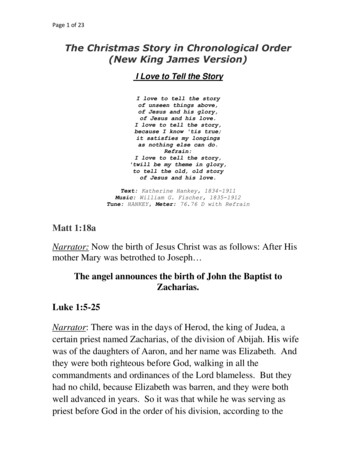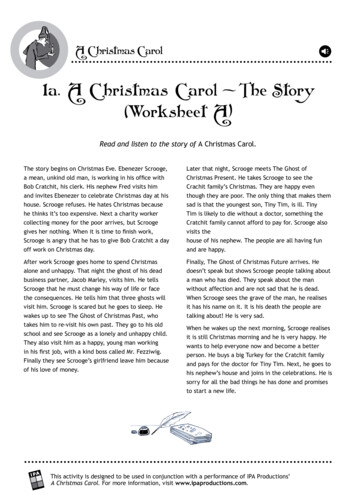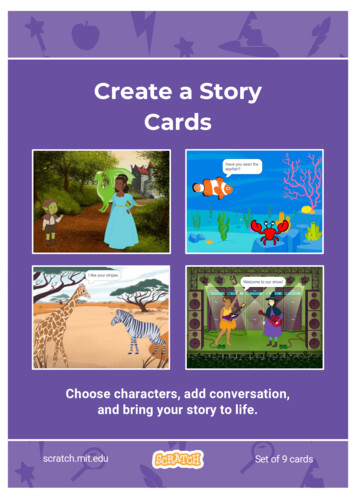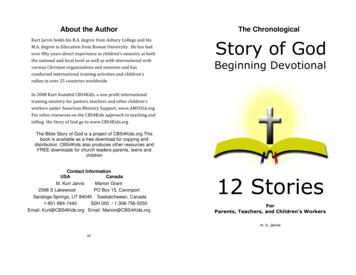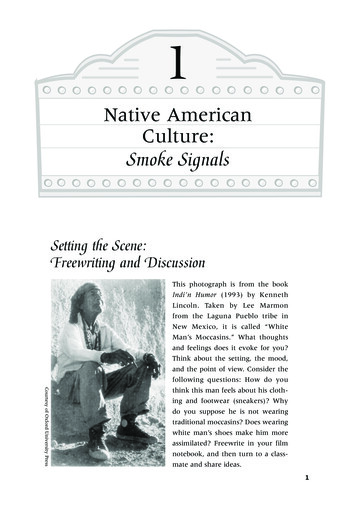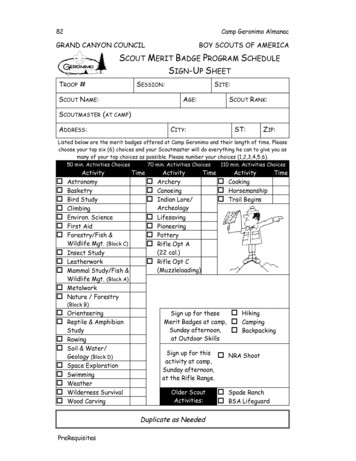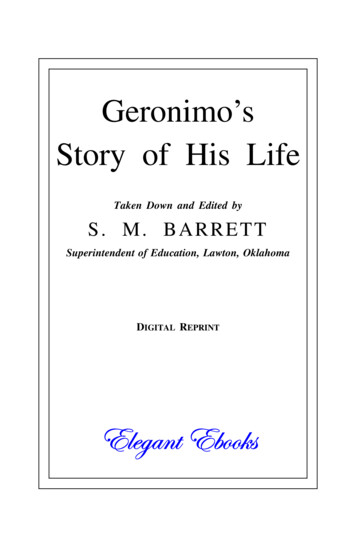
Transcription
Geronimo’sStory of His LifeTaken Down and Edited byS. M. BARRETTSuperintendent of Education, Lawton, OklahomaDIGITAL REPRINTElegant Ebooks
COPYRIGHT INFORMATIONBook: Geronimo’s Story of His LifeAuthors: Geronimo, 1829–1909S. M. (Stephen Melvil) Barrett, 1865–?First published: 1906The original book is in the public domain in the United Statesand in some other countries as well. However, it is unknownwhen S. M. Barrett died. Depending on the year of his death, thebook may still be under copyright in countries that use the life ofthe author 70 years (or more) for the duration of copyright.Readers outside the United States should check their owncountries’ copyright laws to be certain they can legally downloadthis ebook. The Online Books Page has an FAQ which gives asummary of copyright durations for many other countries, aswell as links to more official sources.This PDF ebook wascreated by José Menéndez.NOTE ON THE TEXTThe text and illustrations used in this ebook are from aphotographic reprint of the 1906 first edition. A number oftypographical errors in the paper book have been corrected, butto preserve all of the original book, the misprints are included infootnotes signed “J.M.” The line breaks and pagination of theoriginal book have also been reproduced. In addition, a fewendnotes (also signed “J.M.”) have been added to point out someother errors and inconsistencies in the original book.I would like to express my thanks to Mr. Lenny Silverman atthe New Mexico State University Library’s Archives and SpecialCollections department for providing me with several page scansfrom NMSU’s copy of the 1907 edition. They were very helpfulin resolving some—but not all—of the problems with the 1906edition.
Geronimo’sStory of His LifeTaken Down and Edited byS. M. BARRETTSuperintendent of Education, Lawton, OklahomaNEW YORKDUFFIELD & COMPANY1906
Copyright, 1905, byS. M. BARRETTCopyright, 1906, byDUFFIELD & COMPANYPublished September, 1906
DEDICATORYBecause he has given me permission to tellmy story; because he has read that story andknows I try to speak the truth; because Ibelieve that he is fair-minded and will causemy people to receive justice in the future;and because he is chief of a great people, Idedicate this story of my life to TheodoreRoosevelt, President of the United States.GERONIMO.iii
PREFACETHE initial idea of the compilation ofthis work was to give the reading publican authentic record of the private life of theApache Indians, and to extend to Geronimoas a prisoner of war the courtesy due anycaptive, i.e., the right to state the causeswhich impelled him in his opposition to ourcivilization and laws.If the Indians’ cause has been properlypresented, the captives’ defense clearlystated, and the general store of information regarding vanishing types increased, Ishall be satisfied.I desire to acknowledge valuable suggestions from Maj. Charles Taylor, FortSill, Oklahoma; Dr. J. M. Greenwood,Kansas City, Missouri, and President DavidR. Boyd, of the University of Oklahoma.v
PREFACEI especially desire in this connection tosay that without the kindly advice and assistance of President Theodore Rooseveltthis book could not have been written.Respectfully,S. M. BARRETT.LAWTON, OKLAHOMA.August 14, 1906.vi
CONTENTSCHAPTERPAGEINTRODUCTORY .xiAPACHE INDIANS .3II. S UBDIVISIONS OF THE APACHE TRIBE . .III. EARLY LIFE . . . . . . . . .IV. TRIBAL AMUSEMENTS, M ANNERS, ANDC USTOMS . . . . . . . . .V. THE FAMILY . . . . . . . . .1217PART IThe ApachesI. ORIGINOF THE2635PART IIThe MexicansVI.VII.VIII.IX.X.XI.XII.KAS -KI-YEH . . . . . .FIGHTING UNDER DIFFICULTIESR AIDS THAT WERE S UCCESSFULVARYING FORTUNES. . .OTHER RAIDS . . . . .HEAVY FIGHTING. . . .GERONIMO’S M IGHTIEST BATTLEvii.435569798698105
CONTENTSPART IIIThe White MenCHAPTERPAGEXIII. C OMING OF THE WHITE M ENXIV. GREATEST OF WRONGS. . 113. *119. 126.131139148177UNWRITTEN LAWS OF THE APACHESAT THE W ORLD’S FAIR . . . .R ELIGION . . . . . . . .HOPES FOR THE FUTURE . . . .185197207213XV. R EMOVALS .XVI.XVII.XVIII.XIX.IN P RISON AND ON THE WARPATHTHE FINAL S TRUGGLE . . . .S URRENDER OF GERONIMO. .A PRISONER OF W AR . . . .PART IVThe Old and the NewXX.XXI.XXII.XXIII.viii*116 — J.M.
LIST OF ILLUSTRATIONSGeronimo .FrontispieceHow the book was made. Facing page viDressed as in days of old.8Naiche (Natches), son of Cochise, hereditary chief of the Chiricahua Apaches.Naiche was Geronimo’s lieutenant duringthe protracted wars in Arizona.14Last of the Bedonkohe Apache Tribe, Tuklonnen,Nädeste,Nah-ta-neal,Poricoa(White Horse).18Work stock in Apache corral .22The conquered weapon.30Apache princess, daughter of Naiche, chiefof the Chiricahua Apaches.38*Geronimo, Chihuahua, Nanne, Loco, Ozonne .46Naiche, his mother, his two wives and hischildren.50Asa Deklugie, wife and children.66Apache scouts—Naiche, Goody, John Loco,Porico, Jasen, Asa Deklugie, Kelburn,Sam, Hugh, Captain Seyers b .70Three Apache chieftains—Naiche, son ofCochise;† Asa, son of Whoa; Charlie,‡ sonof § Victoria .80ix*§Ozone — J.M.†Coche; — J.M.The word “of” was missing. — J.M.c‡Charley, — J.M.
xLIST OF ILLUSTRATIONSApache camp .Facing page 86Apache mission—Valley of Medicine Creek,Fort Sill Military Reservation.96Asa Deklugie (official interpreter for Geronimo, son of Whoa, chief of the NedniApaches, chief elect to succeed Geronimoat the latter’s death)Geronimo, Apache war chief .100*Lone Wolf, chief of KiowasGeronimo, Apache war chief .108dQuanna Parker, chief of Comanche Indians118Gotebo, war chief, Kiowa Indians.144eKaytah and Nahteen, Apache scouts whowere with Captain † Lawton .152‡Emma Tuklonnen .162fW. F. Melton, at whose camp in SkeletonCañon Geronimo surrendered.172Chihuahua and family.190Mrs. Asa Deklugie, niece of Geronimo anddaughter of Chihuahua, a famous Apachechieftain .200Eva Geronimo, Geronimo’s youngest daughter, 16 years old .200Ready for church .210*Wolfe, — J.M.†General (According to the main text, Lawton was a captain. Cf. pages140, 142fn, 143, 144, 150, 153, 154, 163–164, 165, 166, 169, 171,173.) — J.M.‡Tuklonen (Correction is based on the 1907 edition.) — J.M.
INTRODUCTORYI FIRST met Geronimo in the summer of1904, when I acted for him as interpreter ofEnglish into Spanish, and vice versa, in selling a war bonnet. After that he always hada pleasant word for me when we met, butnever entered into a general conversationwith me until he learned that I had oncebeen wounded by a Mexican. As soon ashe was told of this, he came to see me andexpressed freely his opinion of the averageMexican, and his aversion to all Mexicans ingeneral.I invited him to visit me again, which hedid, and upon his invitation, I visited him athis tepee in the Fort Sill Military reservation.In the summer of 1905 Dr. J. M. Greenwood, superintendent of schools at Kansasxi
INTRODUCTORYCity, Missouri, visited me, and I took himto see the chief. Geronimo was quiteformal and reserved until Dr. Greenwoodsaid, “I am a friend of General Howard,whom I have heard speak of you.”“Come,” said Geronimo, and led the wayto a shade, had seats brought for us, puton his war bonnet, and served watermelonà l’Apache (cut in big chunks), while hetalked freely and cheerfully. When we lefthe gave us a pressing invitation to visit himagain.In a few days the old chief came to seeme and asked about “my father.” I said,“You* mean the old gentleman from KansasCity—he has returned to his home.” “Heis your† father?” said Geronimo. “No,” Isaid, “my father died twenty-five yearsago, Dr. Greenwood is only my friend.”After a moment’s silence the old Indianspoke again, this time in a tone of voice intended to carry conviction, or at least toallow no further discussion. “Your naturalxii*said “you — J.M.†you — J.M.
INTRODUCTORYfather is dead, this man has been your friendand adviser from youth. By adoption he isyour father. Tell him he is welcome tocome to my home at any time.” It was ofno use to explain any more, for the old manhad determined not to understand my relation to Dr. Greenwood except in accordancewith Indian customs, and I let the matterdrop.In the latter part of that summer I askedthe old chief to allow me to publish some ofthe things he had told me, but he objected,saying, however, that if I would pay him,and if the officers in charge did not object,he would tell me the whole story of his life.I immediately called at the fort (Fort Sill)and asked the officer in charge, LieutenantPurington, for permission to write the lifeof Geronimo. I was promptly informedthat the privilege would not be granted.Lieutenant Purington explained to me themany depredations committed by Geronimoand his warriors, and the enormous cost ofxiii
INTRODUCTORYsubduing the Apaches, adding that the oldApache deserved to be hanged rather thanspoiled by so much attention from civilians.A suggestion from me that our governmenthad paid many soldiers and officers to goto Arizona and kill Geronimo and theApaches, and that they did not seem to knowhow to do it, did not prove very gratifyingto the pride of the regular army officer, andI decided to seek elsewhere for permission.Accordingly I wrote to President Rooseveltthat here was an old Indian who had beenheld a prisoner of war for twenty years andhad never been given a chance to tell his sideof the story, and asked that Geronimo begranted permission to tell for publication, inhis own way, the story of his life, and thathe be guaranteed that the publication of hisstory would not affect unfavorably theApache prisoners of war. By return mailI received word that the authority had beengranted. In a few days I received wordfrom Fort Sill that the President hadxiv
INTRODUCTORYordered the officer in charge to grant permission as requested. An interview was requested that I might receive the instructionsof the War Department. When I went toFort Sill the officer in command handed methe following brief, which constituted myinstructions:LAWTON, O KLAHOMA , Aug. 12th, 1905.Geronimo,—Apache Chief—S. M. BARRETT, Supt. Schools.Letter to the President stating that above-mentioned desires to tell his life story that it may be published, and requests permission to tell it in his ownway, and also desires assurance that what he has tosay will in no way work a hardship for the Apachetribe.1st Endorsement.W AR D EPARTMENT,*THE M ILITARY S ECRETARY’ S O FFICE,W ASHINGTON, August 25th, 1905.Respectfully referred, by direction of the ActingChief of Staff, through headquarters, Department ofxv*DAPARTMENT, — J.M.
INTRODUCTORYTexas, to the Officer In Charge of the Apache prisoners of war at Fort Sill, Oklahoma Territory, forremark and recommendation.(Signed) E. F. LADD,Military Secretary.2d Endorsement.HEADQUARTERS DEPARTMENT OF TEXAS,M ILITARY S ECRETARY’S OFFICE,S AN ANTONIO, August 29th, 1905.Respectfully transmitted to 1st Lieut. George A.Purington, 8th Cavalry, In Charge of Apache prisoners. (Thro’ Commanding Officer, Fort Sill, O. T.)By Command of Brigadier General Lee.(Signed) C. D. ROBERTS,Captain, 7th Infantry,Acting Military Secretary.3d Endorsement.FORT SILL, O. T., Aug. 31st, 1905.Respectfully referred to 1st Lieut. G. A. Purington,* 8th Cavalry, Officer in Charge of Apache prisoners of war, for remark and recommendation.By Order of Captain Dade.(Signed) J AMES LONGSTREET,1st. Lieut. & Sqdn. Adjt., 13th Cavalry. Adjutant.xvi*tion, — J.M.
INTRODUCTORY4th Endorsement.FORT S ILL, O. T., Sept. 2d, 1905.Respectfully returned to the Adjutant, Fort Sill,O. T. I can see no objection to Geronimo telling thestory of his past life, providing he tells the truth. Iwould recommend that Mr. S. M. Barrett be heldresponsible for what is written and published.(Signed) GEO. A. PURINGTON,1st. Lieut. 8th Cavalry,In Charge of Apache prisoners of war.5th Endorsement.FORT SILL, O. T., Sept. 4th, 1905.Respectfully returned to the Military Secretary,Dept. of Texas, San Antonio, Texas, inviting attention to 4th endorsement hereon. It is recommendedthat the manuscript be submitted before publicationto Lieut. Purington, who can pass upon the truth ofthe story.(Signed) A. L. DADE,Captain, 13th Cavalry, Commanding.6th Endorsement.HEADQUARTERS DEPT. OF TEXAS,SAN ANTONIO, September 8th, 1905.Respectfully returned to the Military Secretary,xvii
INTRODUCTORYWar Department, Washington, D. C., inviting attention to the preceding endorsement hereon, whichis concurred in.(Signed) J. M. LEE,Brigadier General, Commanding.7th Endorsement.W AR D EPARTMENT,OFFICE OF THE C HIEF OF S TAFF,W ASHINGTON, September 13th, 1905.Respectfully submitted to the Honorable the Secretary of War, inviting attention to the foregoingendorsements.(Signed) J. C. BATES,Major General, Acting Chief of Staff.8th Endorsement.W AR DEPARTMENT,September 15th, 1905.Respectfully returned to the Acting Chief of Staffto grant the necessary authority in this matter,through official channels, with the express understanding that the manuscript of the book shall be submittedto him before publication. Upon receipt of suchmanuscript the Chief of Staff will submit it to suchperson as he may select as competent to make axviii
INTRODUCTORYproper and critical inspection of the proposed publication.(Signed) R OBERT S HAW OLIVER,Acting Secretary of War.9th Endorsement.W AR DEPARTMENT,THE M ILITARY S ECRETARY’S OFFICE,W ASHINGTON, September 18th, 1905.Respectfully returned, by direction of the ActingChief of Staff, to the Commanding General, Dept. ofTexas, who will give the necessary instructions forcarrying out the directions of the Acting Secretaryof War, contained in the 8th endorsement. It isdesired that Mr. Barrett be advised accordingly.(Signed) HENRY P. MC CAIN,Military Secretary.10th Endorsement.HEADQUARTERS DEPT. OF TEXAS,M ILITARY SECRETARY’S OFFICE,S AN ANTONIO, September 23, 1905.Respectfully referred to the Commanding Officer,Fort Sill, Oklahoma Territory, who will give thenecessary instructions for carrying out the directionof the Acting Secretary of War contained in the 8thendorsement hereon.xix
INTRODUCTORYThis paper will be shown and fully explained toMr. Barrett, and then returned to these headquarters.By order of Colonel Hughes.(Signed) GEO. VAN HORN MOSELEY,1st. Lieut. 1st Cavalry, Aide-de-Camp,Acting Military Secretary.Early in October I secured the services ofan educated Indian, Asa Deklugie, son ofWhoa, chief of the Nedni Apaches, as interpreter, and the work of compiling thebook began.Geronimo refused to talk when a stenographer was present, or to wait for corrections or questions when telling the story.Each day he had in mind what he would telland told it in a very clear, brief manner.He might prefer to talk at his own tepee, atAsa Deklugie’s house, in some mountaindell, or as he rode in a swinging gallop acrossthe prairie; wherever his fancy led him,there he told whatever he wished to tell andno more. On the day that he first gave anyportion of his autobiography he would notxx
INTRODUCTORYbe questioned about any details, nor wouldhe add another word, but simply said,“Write what I have spoken,” and left usto remember and write the story without onebit of assistance. He would agree, however,to come on another day to my study, or anyplace designated by me, and listen to thereproduction (in Apache) of what had beentold, and at such times would answer allquestions or add information wherever hecould be convinced that it was necessary.He soon became so tired of book makingthat he would have abandoned the task butfor the fact that he had agreed to tell thecomplete story. When he once gives hisword, nothing will turn him from fulfillinghis promise. A very striking illustration ofthis was furnished by him early in January,1906. He had agreed to come to my studyon a certain date, but at the appointed hourthe interpreter came alone, and said thatGeronimo was very sick with cold and fever.He had come to tell me that we must apxxi
INTRODUCTORYpoint another date, as he feared the old warrior had an attack of pneumonia. It was acold day and the interpreter drew a chair upto the grate to warm himself after the exposure of the long ride. Just as he wasseating himself he looked out of the window,then rose quickly, and without speakingpointed to a rapidly moving object comingour way. In a moment I recognized the oldchief riding furiously (evidently trying toarrive as soon as the interpreter did), hishorse flecked with foam and reeling fromexhaustion. Dismounting he came in andsaid in a hoarse whisper, “I promised tocome. I am here.”I explained to him that I had not expected him to come on such a stormy day,and that in his physical condition he mustnot try to work. He stood for some time,and then without speaking left the room, remounted his tired pony, and with bowedhead faced ten long miles of cold north wind—he had kept his promise.xxii
INTRODUCTORYWhen he had finished his story I submitted the manuscript to Major Charles W.Taylor, Eighteenth Cavalry, commandant,Fort Sill, Oklahoma, who gave me some valuable suggestions as to additional relatedinformation which I asked Geronimo togive. In most cases the old chief gave thedesired information, but in some instanceshe refused, stating his reasons for so doing.When the added information had been incorporated I submitted the manuscript toPresident Roosevelt, from whose letter Iquote: “This is a very interesting volumewhich you have in manuscript, but I wouldadvise that you disclaim responsibility in allcases where the reputation of an individualis assailed.”In accordance with that suggestion, Ihave appended notes throughout the bookdisclaiming responsibility for adverse criticisms of any persons mentioned by Geronimo.On June 2d, 1906, I transmitted thexxiii
INTRODUCTORYcomplete manuscript to the War Department. The following quotation is from theletter of transmission:“In accordance with endorsement number eight ofthe ‘Brief’ submitted to me by the commandingofficer of Fort Sill, which endorsement constituted theinstructions of the Department, I submit herewithmanuscript of the Autobiography of Geronimo.“The manuscript has been submitted to the President, and at his suggestion I have disclaimed anyresponsibility for the criticisms (made by Geronimo)of individuals mentioned.”Six weeks after the manuscript was forwarded, Thomas C. Barry, Brigadier General, Assistant to the Chief of Staff, sent tothe President the following:“M EMORANDUM FOR THE S ECRETARY OF W AR.“Subject: Manuscript of the Autobiography ofGeronimo. The paper herewith, which was referredto this office on July 6th, with instructions to reportas to whether there is anything objectionable in it, isreturned.“The manuscript is an interesting autobiographyof a notable Indian, made by himself. There are axxiv
INTRODUCTORYnumber of passages which, from the departmentalpoint of view, are decidedly objectionable. These arefound on pages 73, 74, 90, 91, and 97, and are indicated by marginal lines in red. The entire manuscript appears in a way important as showing theIndian side of a prolonged controversy, but it isbelieved that the document, either in whole or in part,should not receive the approval of the War Department.”The memorandum is published that theobjections of the War Department may bemade known to the public.The objection is raised to the mention onpages seventy-three and seventy-four of themanuscript of an attack upon Indians in atent at Apache Pass or Bowie, by U. S.soldiers. The statement of Geronimo is,however, substantially confirmed by L. C.Hughes, editor of The Star, Tucson,Arizona.On pages ninety and ninety-one of themanuscript, Geronimo criticised GeneralCrook. This criticism is simply Geronimo’sprivate opinion of General Crook. Wexxv
INTRODUCTORYdeem it a personal matter and leave it without comment, as it in no way concerns thehistory of the Apaches.On page ninety-seven of the manuscriptGeronimo accuses General Miles of badfaith. Of course, General Miles made thetreaty with the Apaches, but we know verywell that he is not responsible for the waythe Government subsequently treated theprisoners of war. However, Geronimo cannot understand this and fixes upon GeneralMiles the blame for what he calls unjusttreatment.One could not expect the Department ofWar to approve adverse criticisms of itsown acts, but it is especially gratifying thatsuch a liberal view has been taken of thesecriticisms, and also that such a frank statement of the merits of the Autobiography issubmitted in the memorandum. Of courseneither the President nor the War Department is in any way responsible for whatGeronimo says; he has simply been grantedxxvi
INTRODUCTORYthe opportunity to state his own case as hesees it.The fact that Geronimo has told the storyin his own way is doubtless the only excusenecessary to offer for the many unconventional features of this work.xxvii
PART ITHE APACHES
GERONIMOCHAPTER IORIGIN OF THE APACHE INDIANSIN the beginning the world was coveredwith darkness. There was no sun, noday. The perpetual night had no moon orstars.There were, however, all manner of beastsand birds. Among the beasts were manyhideous, nameless monsters, as well asdragons, lions, tigers, wolves, foxes, beavers,rabbits, squirrels, rats, mice, and all mannerof creeping things such as lizards and serpents. Mankind could not prosper undersuch conditions, for the beasts and serpentsdestroyed all human offspring.All creatures had the power of speech andwere gifted with reason.There were two tribes of creatures: thebirds or the feathered tribe and the beasts.3
GERONIMOThe former were organized under theirchief, the eagle.These tribes often held councils, and thebirds wanted light admitted. This the beastsrepeatedly refused to do. Finally the birdsmade war against the beasts.The beasts were armed with clubs, but theeagle had taught his tribe to use bows andarrows. The serpents were so wise that theycould not all be killed. One took refuge ina perpendicular cliff of a mountain in Arizona, and his eye (changed into a brilliantstone) may be seen in that rock to this day.The bears, when killed, would each bechanged into several other bears, so that themore bears the feathered tribe killed, themore there were. The dragon could not bekilled, either, for he was covered withfour coats of horny scales, and the arrowswould not penetrate these. One of themost hideous, vile monsters (nameless) wasproof against arrows, so the eagle flewhigh up in the air with a round, white4
ORIGIN OF THE APACHEstone, and let it fall on this monster’shead, killing him instantly. This was sucha good service that the stone was calledsacred. (A symbol of this stone is used inthe tribal game of Kah.1) They foughtfor many days, but at last the birds won thevictory.After this war was over, although someevil beasts remained, the birds were able tocontrol the councils, and light was admitted.Then mankind could live and prosper. Theeagle was chief in this good fight: therefore,his feathers were worn by man as emblemsof wisdom, justice, and power.Among the few human beings that wereyet alive was a woman who had been blessedwith many children, but these had alwaysbeen destroyed by the beasts. If by anymeans she succeeded in eluding the others,the dragon, who was very wise and very evil,would come himself and eat her babes.After many years a son of the rainstorm1See Chapter IV.5
GERONIMOwas born to her and she dug for him a deepcave. The entrance to this cave she closedand over the spot built a camp fire. Thisconcealed the babe’s hiding place and kepthim warm. Every day she would removethe fire and descend into the cave, where thechild’s bed was, to nurse him; then shewould return and rebuild the camp fire.Frequently the dragon would come andquestion her, but she would say, “I have nomore children; you have eaten all of them.”When the child was larger he would notalways stay in the cave, for he sometimeswanted to run and play. Once the dragonsaw his tracks. Now this perplexed and enraged the old dragon, for he could not findthe hiding place of the boy; but he said thathe would destroy the mother if she did notreveal the child’s hiding place. The poormother was very much troubled; she couldnot give up her child, but she knew thepower and cunning of the dragon, thereforeshe lived in constant fear.6
ORIGIN OF THE APACHESoon after this the boy said that hewished to go hunting. The mother wouldnot give her consent. She told him of thedragon, the wolves, and the serpents; but hesaid, “To-morrow I go.”At the boy’s request his uncle (who wasthe only man then living) made a little bowand some arrows for him, and the two wenthunting the next day. They trailed the deerfar up the mountain and finally the boykilled a buck. His uncle showed him how todress the deer and broil the meat. Theybroiled two hind quarters, one for the childand one for his uncle. When the meat wasdone they placed it on some bushes to cool.Just then the huge form of the dragon appeared. The child was not afraid, but hisuncle was so dumb with fright that he didnot speak or move.The dragon took the boy’s parcel of meatand went aside with it. He placed the meaton another bush and seated himself besideit. Then he said, “This is the child I have7
GERONIMObeen seeking. Boy, you are nice and fat,so when I have eaten this venison I shall eatyou.” The boy said, “No, you shall not eatme, and you shall not eat that meat.” So hewalked over to where the dragon sat andtook the meat back to his own seat. Thedragon said, “I like your courage, but youare foolish; what do you think you coulddo?” “Well,” said the boy, “I can doenough to protect myself, as you may findout.” Then the dragon took the meat again,and then the boy retook it. Four times inall the dragon took the meat, and after thefourth time the boy replaced the meat hesaid, “Dragon, will you fight me?” Thedragon said, “Yes, in whatever way youlike.” The boy said, “I will stand one hundred paces distant from you and you mayhave four shots at me with your bow andarrows, provided that you will then exchange places with me and give me fourshots.” “Good,” said the dragon. “Standup.”8
ORIGIN OF THE APACHEThen the dragon took his bow, which wasmade of a large pine tree. He took four arrows from his quiver; they were made ofyoung pine tree saplings, and each arrowwas twenty feet in length. He took deliberate aim, but just as the arrow left the bowthe boy made a peculiar sound and leapedinto the air. Immediately the arrow wasshivered into a thousand splinters, and theboy was seen standing on the top of a brightrainbow over the spot where the dragon’saim had been directed. Soon the rainbow wasgone and the boy was standing on the groundagain. Four times this was repeated, thenthe boy said, “Dragon, stand here; it is mytime to shoot.” The dragon said, “Allright; your little arrows cannot pierce myfirst coat of horn, and I have three othercoats—shoot away.” The boy shot an arrow, striking the dragon just over the heart,and one coat of the great horny scales fellto the ground. The next shot another coat,and then another, and the dragon’s heart was9
GERONIMOexposed. Then the dragon trembled, butcould not move. Before the fourth arrowwas shot the boy said, “Uncle, you aredumb with fear; you have not moved; comehere or the dragon will fall on you.” Hisuncle ran toward him. Then he sped thefourth arrow with true aim, and it piercedthe dragon’s heart. With a tremendousroar the dragon rolled down the mountainside—down four precipices into a cañonbelow.Immediately storm clouds swept the mountains, lightning flashed, thunder rolled, andthe rain poured. When the rainstorm hadpassed, far down in the cañon below, theycould see fragments of the huge body of thedragon lying among the rocks, and the bonesof this dragon may still be found there.This boy’s name was Apache. Usen 2taught him how to prepare herbs for medi2Usen is the Apache word for God. It is used here because it implies the attributes of deity that are held intheir primitive religion. “Apache” means “Enemy.”10
ORIGIN OF THE APACHEcine, how to hunt, and how to fight. He wasthe first chief of the Indians and wore theeagle’s feathers as the sign of justice, wisdom, and power. To him, and to his people,as they were created, Usen gave homes in theland of the west.11
CHAPTER IISUBDIVISIONS OF THE APACHE TRIBETHE Apache Indians are divided intosix sub-tribes. To one of these, theBe-don-ko-he, I belong.Our tribe inhabited that region of mountainous country which lies west from the eastline of Arizona, and south from the headwaters of the Gila River.East of us lived the Chi-hen-ne (OjoCaliente), (Hot Springs) Apaches. Ourtribe never had any difficulty with them.Victoria, their chief, was always a friend tome. He always helped our tribe when weasked him for help. He lost his life in thedefense of the rights of his people. He wasa good man and a brave warrior. His sonCharlie now lives here in this reservationwith us.12
THE APACHE TRIBENorth of us lived the White MountainApaches. They were not always on the bestof terms with our tribe, yet we seldom hadany war with them. I knew their chief,Hash-ka-ai-la, personally, and I consideredhim a good warrior. Their range was nextto that of the Navajo Indians, who were notof the same blood as the Apaches. We heldcouncils with all Apache tribes, but neverwith the Navajo Indians. However, wetraded with them and sometimes visitedthem.To the west of our country ranged theChi-e-a-hen Apaches. They had two chiefswithin my time, Co-si-to and Co-da-hoo-yah.They were friendly, but not intimate withour tribe.South of us lived the Cho-kon-en (Chiricahua) Apaches, whose chief in the old dayswas Co-chise, and later his son, Naiche. Thistribe was always on the most friendly termswith us. We were often in camp and onthe trail together. Naiche, who wa
this ebook. The Online Books Page has an FAQ which gives a summary of copyright durations for many other countries, as well as links to more official sources. This PDF ebook was created by José Menéndez. NOTE ON THE TEXT The text and illustrations used in this ebook are from a ph
